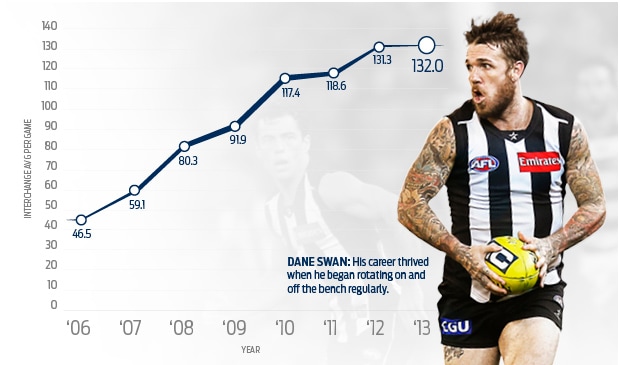The average total of interchanges per club per game in 2013 sits at 132, an increase of just 0.7 per team per game from the previous year.
A team has made fewer than 120 interchanges per game just 38 times so far this season (or on 16 per cent of occasions) and more than 140 interchanges on 50 occasions (or 21 per cent).
Clubs sit within a band of between 120 and 140 interchanges 63 per cent of the time.
It appears most have found an optimum level within that range.
With figures stable, the introduction of new rules in 2013 relating to throwing up the ball and kicking it back in has reduced top speeds anyway, according to anecdotal feedback from clubs AFL.com.au contacted.
A team has made fewer than 100 interchanges in a game only four times in 2013. That team has lost on each occasion.
That's nowhere near the cap of 80 reportedly recommended to the AFL Commission in October 2012.
The lowest number of interchanges recorded by a team in 2013 was in round four when the Bulldogs made just 87 interchanges in the wet against Adelaide, while the Crows hold the record for the most per game, having made 169 interchanges in rounds two and three.
Most observers believe making 169 changes in 120 minutes of football almost reduces a team to playing with 17 men.
It is too many, too disruptive and a sign of a plan going off-kilter.
The potential for game-day disruption on the bench should be a key consideration in any recommendation.
The administrative and adjudicating burden that would come with keeping record of the number of interchanges made per game, or per quarter, would need to have a material effect on the contest to be worth the League's while.
The interchange area is already chaotic with the concussion sub rule, the sub rule and the rule relating to interchange breaches.
A cap might turn it into a mosh pit.
Any introduction would also raise pertinent questions such as an appropriate penalty for breaching the cap and who would be employed at each club to monitor the rate of interchange.
While the supposed cause and effect relationship between injury and interchange numbers will always be debated, it can be argued that recent rule changes have also contributed to an improvement in player welfare.
But if the risk was OK in 2013, it's hard to see it being unacceptable next season - particularly with players traditionally against the idea of interchanges being severely restricted.
With so many youngsters in the game as a result of 18 teams, the cap would have a greater impact on a team such as Greater Western Sydney.
The Giants have not made fewer than 130 interchanges per game this season and average 142 interchanges per game.
First-year player Port Adelaide's Ollie Wines (139 interchanges) is the second most rotated player in the competition behind Fremantle's Danyle Pearce (140).
Of the top four teams, two - Geelong (from 144 to 130 per game) and Essendon (129 to 124 per game) – have reduced their average number of interchanges in 2013 compared to 2012.
Hawthorn has increased its average number of interchanges from 135 to 143 while the Swans have average exactly the same number in 2013 (122 per game) as they averaged in 2012.
Evans has the respect of the clubs and the clubs, happy with the reception to their arguments, are allowing the process to take its course.
It's time to forget the idea that cap is in no matter what, and examine the evidence with all options, including further deferral, under consideration.
With the issue expected to be on the agenda at the next AFL Commission meeting, the debate - which has been quiet lately - is not far off starting again.
Despite some clubs saying they need an answer as soon as possible, the right decision is more important than a decision at the right time.
To cap or not to cap should remain an open question when it comes to the interchange in 2014.
Stats supplied by Champion Data



